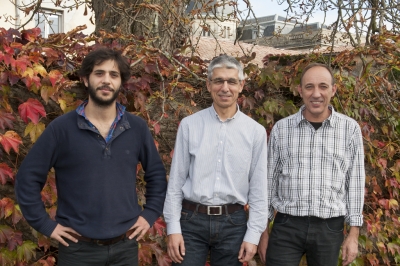
Agroecology Reading time 6 min
Dominique Blancard, a friendly font of agri-knowledge
Published on 02 December 2013
At the interstice of research and the agricultural sector
Blancard is a walking pharmacopoeia. He has an encyclopaedic knowledge of plant diseases, and is also at the forefront of communication technology, keen to share his abilities with the widest audience possible at the click of a button.
For someone who did not want to pursue studies at a younger age, Blancard certainly has collected a fair few degrees! Following an associate’s degree in applied biology, this long time resident of Périgord pursued a master’s degree in science and technology that introduced him to phytopathology, the study of plant–pathogen interactions. The discovery led him to a postgraduate degree in crop plant pathology at INRA that he completed concurrently with a postgraduate degree in business management. The boy who dreamed of becoming a doctor one day ended up becoming a doctor for fruits and vegetables!
Hired in 1980 by INRA Avignon’s plant pathology unit, Blancard began his work on tomato diseases, “my fetish plant” he says. “Tomatoes are an extraordinary biological model. They have surprising potential, and are able to cohabitate with over 400 pathogens! Grown under shelter, without soil, tomato cultivation is extremely technical.” Blancard spent ten years investigating tomatoes, “the best years of my life” he says, working as an engineer at the interstice of research and the agricultural sector. Sanitary requirements in the vegetable industry are stringent; market gardeners are constantly faced with new threats as they import plants and plant substrates. In the fields and in his lab, Blancard identified diseases, and studied pathogens and their effects on plants. With a camera in his pocket, this young engineer with a tremendous visual memory set out to compile a photographic collection of disease symptoms. In 1984, he published his first work on tomato diseases. It became widely successful as most pathology reference books at the time relied instead on illustrations. Blancard has made a habit of applying his expertise across a range of media, from CD ROMs, to an expert system and a website, all of which are international benchmarks in their fields today.
A true vegephile
After tomatoes came tobacco. Working with the Tobacco Institute as head of its plant pathology laboratory, Blancard studied diagnostics, bacterial etiology and the etiology of poorly understood viruses, evaluated defence stimulators, bred plants for disease resistance, and more. He also reorganised the lab, investigated diseases, modernised protection methods, coordinated an international tobacco research network, published works, and trained a technician.
Blancard then turned his focus to grapes and went to work at INRA Bordeaux. There he studied acid rot and the impact of moulds on wine taste. Through it all however he never lost sight of his first love, vegetables. “General pathologists like me are a dying breed. Our knowledge must not be allowed to disappear” he says. As a knowledge engineer, his aim is always to strike the right balance between research, research promotion, and educational outreach. The results have been prolific, with a total of 70,000 works sold in five languages and freely available web and smartphone apps, e-Phytia, Di@gnoplant, and Vigipl@nt. For some ten years now, Blancard has also been coordinating a small team developing very high quality, easy to use, multipurpose web and mobile products that can be used to identify diseases in the field, offer advice, and provide coaching on plant protection issues. Soon these products will also have epidemiological surveillance and biovigilance features. Di@gnoplant can already be used to identify lettuce, tomato, grapevine, and tobacco diseases. Other products are currently being developed for vegetables. French-language apps for forest trees, beneficial organisms, garden plants, and tropical plants are also being developed, some of which will also be available in English. In his sixties and dynamic, Blancard would like to do even more. “We are looking to create a generic and education tool for identifying diseases in annual plants that would mimic a plant pathologist’s expertise when make diagnoses” he says.

Dominique Blancard is now retired.
